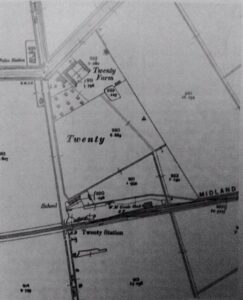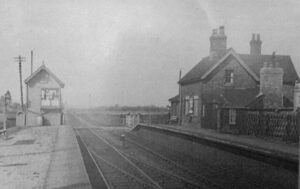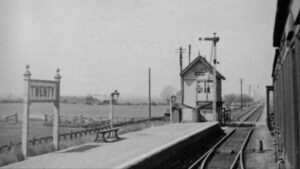Twenty has been the topic of a once famous railway riddle: How many stations are there between Bourne and Spalding?
Twenty is a small village on Bourne Fen, which is 3 miles to the east of Bourne, on the A151 to Spalding. According to an Ordinance Survey Map from 1824, that road was then called Bourne Drove. There was no settlement there back then, just isolated farms in that area.
On August 1st, 1866, nine miles of railway line was opened between Bourne and Spalding. Though there was no intermediate settlement, three stations were established along that line – at Twenty, Counter Drain, and North Drove. These stations were put at convenient spots along the roads leading to farms. The many drains latticing the area usually ran from north to south. The railway line ran east and west, so the stations were placed between the drains to serve the fenland farms and those areas.
There has been a lot of thought as to why Twenty station has been named Twenty.
One theory states it was named after the twentieth milestone on the turnpike between Colsterworth and Spalding. The turnpike was opened in 1756, but the line from Bourne to Spalding began in 1822. Colsterworth and Spalding are 23 miles apart. Twenty crossroads was at about the 7-mile mark from Spalding, and three and a half miles from Bourne, so there wasn’t a milestone with 20 miles on it.
Another theory states that Twenty station was put in Field number 20 on the County Series Ordinance Survey maps. However, as Twenty station opened in 1866, and the First Edition of the map (Lincolnshire CXLI.6) was published in 1887, this theory doesn’t apply.

A third theory suggests the station was named after the drainage system that began here, being next to the twentieth drain along from Bourne. Twenty does lie close to Twenty Drove Drain, but there hasn’t been any evidence proving that was the twentieth drain in the sequence. The first editions of the County Series Ordinance Survey maps show 33 watercourses leading into the drain following Bourne’s north side to Twenty in the late 1880s, and 31 to the south.
The fens were drained in this area beginning in the middle of the 17th century. The land between Kyme Fen and the river Glen (including Bourne Fen) was first drained in 1635-1638, and the South Forty Foot Drain was built to carry water away to river Witham. This land was known as the Lindsey Levels, named after the Earl of Lindsey. Some of these drainage works were unsuccessful and more drainage works had to be carried out in the middle of the 18th century.
Alongside the drainage, roads had to be constructed to help new farmsteads to set up and farm the land. In Lincolnshire, a “Drove” is a fenland silt road. A few droves were made on Bourne Fen, and one of these was Twenty Drove (now called North Drove). Twenty Drove ran north – south from a junction with the Bourne-Spalding road, where, much later, Twenty began as a hamlet.

(Other droves built by the late 19th century, between Bourne and Twenty, were called Meadow Drove, Gouble Park Drove, Barnes Drove, Nook Drove, Pickworths Drove and Fosters Drove. Family names were popular for droves, and Twenty might have been a family name.)
Twenty Drove Drain is on the east side of Twenty Drove. The drain goes south towards the Spalding road junction, then goes east to follow it. The drain doesn’t cross the road to run by Twenty station, but the Drove does. Perhaps the station was named after the Drove. If you know of any other theories, please comment below!
Of the three stations, Twenty station was the only one to develop a settlement. There wasn’t one there when the railway line was built, but buildings amalgamated to form a tiny village. This is somewhat unusual.
In 1876, a Board School was being built there, and by 1887, there was an increased amount of farmsteads and houses, as well as a police station at the road junction. The school was built adjacent to Twenty station, perhaps because the railway was meant to bring children for Counter Drain and possibly North Drove stations.
When the station closed in 1959, there was a community living around Twenty station with its own identity.

The answer to the riddle was “Two and Twenty!”

2 Responses
On Lady Day [March ?] 1888 our Morris ancestors moved from their farm at Twenty in Lincolnshire to Stonea another hamlet in the old Isle of Ely [ now Cambridgeshire ]. They booked a whole train which they loaded with their livestock, cattle sheep and chickens, and themselves. This train departed at 8.00 am. and arrived in Stonea soon after 10 am. Their 10 horses had previously taken the carts loaded with machinery and furniture in several 2 day journeys staying at the Rose and Crown Inn in Thorney overnight.
The land in Twenty and Stonea was owned by the Earl of Ancaster from Grimsthorpe Castle. In 1889 the Earl offered the Stonea land for sale to the sitting tenants who bought it and renamed the farm “Ancaster” as a tribute to the generosity of the Earl.
Fantastic piece of family history please tell us more. Regards Geoff